A Comprehensive Analysis of Caffeine Content in Espresso
This guide details the caffeine content in an espresso shot. We cover the standard average, the variables that cause it to fluctuate, and how it compares to other caffeinated drinks. Understanding these factors helps in managing caffeine intake.
Espresso Caffeine: Averages and Ranges
The average single shot of espresso (one fluid ounce or 30 mL) contains about 63 milligrams (mg) of caffeine, according to the U.S. Department of Agriculture (USDA). 1 However, this is just an average, with the actual content ranging from 30 mg to over 100 mg. 3 This variance is due to factors like the coffee bean type, roast degree, and extraction method.
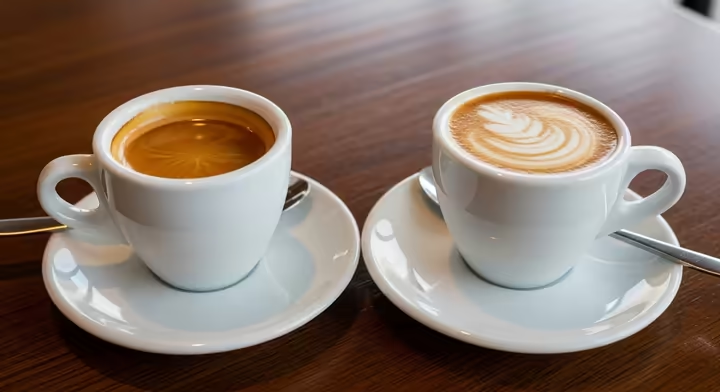
The most common serving size in coffee shops is a double shot, or doppio , which uses twice the coffee to produce two fluid ounces (60 mL). 3 A doppio averages 126 mg of caffeine and is the base for popular drinks like lattes and cappuccinos. 6 Knowing the factors that alter caffeine content is key to monitoring your intake.
Factors That Determine Caffeine Content
The amount of caffeine in an espresso shot is determined by two main factors. These are the properties of the coffee bean and the specifics of the brewing process.
The Influence of the Coffee Bean
A coffee's botanical species is the most significant factor in its potential caffeine content. The two main species are Coffea arabica (Arabica) and Coffea canephora (Robusta). 3
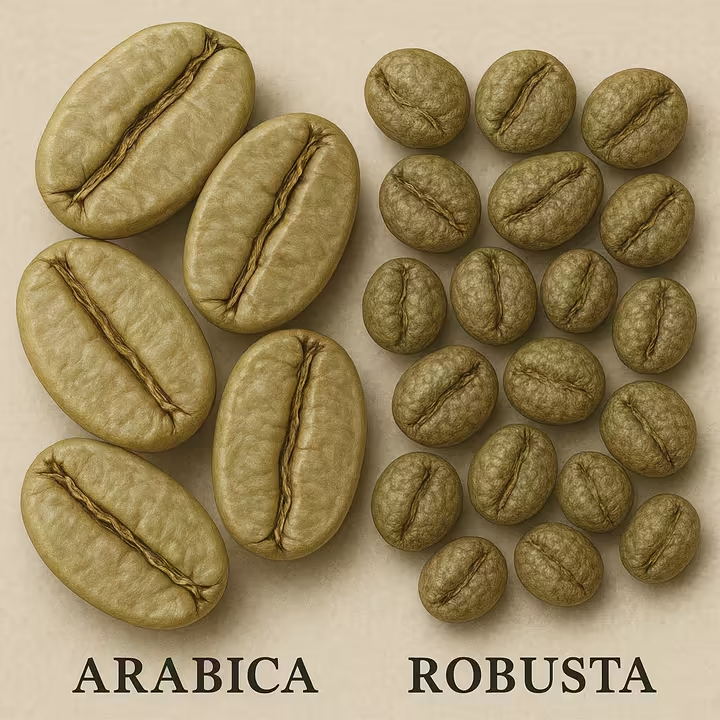
Arabica beans contain 1.2% to 1.5% caffeine by mass, while Robusta beans have nearly double that, at 2.2% to 2.7%. 8 Espresso blends with Robusta will have more caffeine. Traditional Italian blends often include Robusta for both its high caffeine and its ability to produce a thick crema and bold flavor. 9
Many believe darker roasts are stronger, but the effect on caffeine depends on how the coffee is measured. 11 Caffeine is stable during roasting, but beans lose mass and expand, becoming less dense. 13, 14 If measured by volume (scoops), lighter, denser beans yield more caffeine because more beans fit in the scoop. 12
If measured by weight, as professionals do, darker roasts have slightly more caffeine because other compounds have burned off, increasing caffeine's proportion of the total mass. 11 However, this difference is minor compared to the bean type. The blend's composition is a much better indicator of caffeine content than its roast level. 12
The Impact of Extraction and Brewing Method
Espresso brewing uses hot water (195-205°F or 90-96°C) forced through finely ground coffee at nine bars of pressure. 17 This high-pressure method extracts flavor and caffeine quickly, typically in 20-30 seconds. 19 As a water-soluble compound, caffeine is extracted early in the brewing process. 19
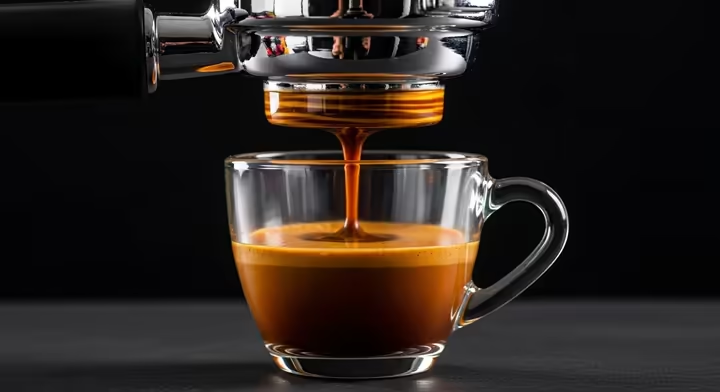
Baristas can adjust several parameters to change the final beverage. The dose, or weight of dry coffee, is a simple variable, as more coffee contains more potential caffeine. 5 A finer grind increases the coffee's surface area, which allows water to dissolve compounds like caffeine more efficiently. 6
The final shot volume, controlled by extraction time, also affects total caffeine. A ristretto ("restricted") uses less water for a shorter, more concentrated shot, extracting less total caffeine despite its intense taste. 20 A lungo ("long") uses more water for a longer extraction, resulting in more total caffeine, even with a milder flavor. 7, 20
This shows that the perceived "strength" of an espresso shot is not a reliable indicator of its total caffeine content.
Caffeine Content by Brand and Organization
Data from major coffee chains, product manufacturers, and health organizations provide useful benchmarks for caffeine content. These figures offer a practical guide for consumers tracking their daily intake.
Major Coffee Chains
Caffeine content varies significantly between coffee chains due to different blends and preparation methods. A single Starbucks Signature Espresso shot has about 75 mg, while their Blonde Espresso has 85 mg. 23, 25 Dunkin's espresso is higher, at 98-118 mg per shot, and Peet’s Coffee reports about 70 mg per shot. 26, 29
| Coffee Chain | Espresso Type | Caffeine per Solo Shot (mg) | Caffeine per Doppio Shot (mg) |
|---|---|---|---|
| Starbucks | Signature Espresso | 75 24 | 150 24 |
| Starbucks | Blonde Espresso | 85 25 | 170 |
| Dunkin' | Espresso | 98-118 27 | 196-236 |
| Peet's Coffee | Espresso | 70 29 | 140 |
Packaged Espresso and General Averages
For Nespresso at-home systems, caffeine content is also variable. Nespresso Original line capsules usually contain 60-90 mg, but high-intensity pods like Kazaar can have up to 125 mg. 30, 32 The Vertuo line's larger pods generally contain more caffeine.
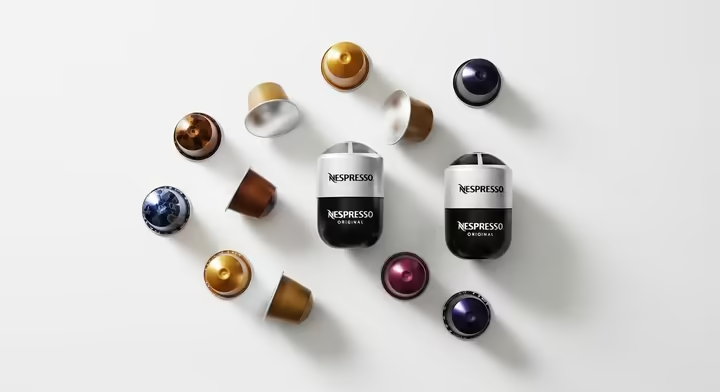
Vertuo espresso pods (40 mL) range from 60 mg to 150 mg, as seen in the Diavolitto pod. Vertuo Double Espresso pods (80 mL) can contain from 120 mg to 200 mg of caffeine. 34
| Nespresso Line | Pod Type | Representative Pod Name | Approx. Caffeine (mg) |
|---|---|---|---|
| Original | Standard Espresso | Roma , Arpeggio | 60 33 |
| Original | High-Caffeine Espresso | Kazaar | 120-125 32 |
| Vertuo | Standard Espresso | Voltesso , Altissio | 85 33 |
| Vertuo | High-Caffeine Espresso | Diavolitto | 150 32 |
| Vertuo | Double Espresso | Double Espresso Scuro | 120-200 34 |
Governmental organizations also provide averages. The USDA lists a generic 1-ounce espresso shot at 63.6 mg of caffeine. 2 The European Food Safety Authority (EFSA) uses a benchmark of 80 mg for a 60 mL (2-ounce) serving. 36
Espresso vs. Other Caffeinated Drinks
To understand espresso's caffeine impact, it's important to compare it to other popular drinks. A key distinction is between caffeine concentration (mg per ounce) and total caffeine per serving. Espresso has a high concentration, but its small serving size affects the total caffeine dose.
Espresso vs. Brewed Coffee and Cold Brew
Espresso has the highest caffeine concentration of common coffee drinks. An ounce of espresso has about 63 mg of caffeine, while an ounce of drip coffee has only 12 mg. 6 This makes espresso over five times more concentrated per ounce.
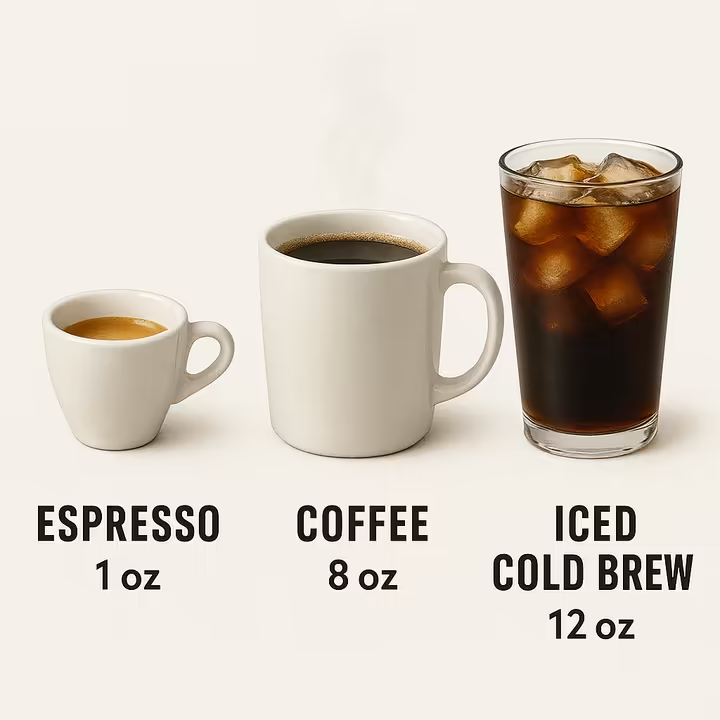
Typical serving sizes are very different, which changes the total caffeine consumed. An 8-ounce cup of drip coffee has about 95 mg of caffeine, often more than a single 63 mg espresso shot. 19 A 12-ounce drip coffee (120-144 mg) or a 12-ounce cold brew (over 200 mg) can contain more total caffeine than a standard 126 mg double espresso. 39
This shows that espresso's intense flavor does not mean it has more total caffeine than larger coffee drinks.
| Beverage | Typical Serving Size | Caffeine Concentration (mg/oz) | Total Caffeine per Serving (mg) |
|---|---|---|---|
| Single Espresso | 1 oz (30 mL) | ~63 6 | ~63 6 |
| Double Espresso (Doppio) | 2 oz (60 mL) | ~63 6 | ~126 6 |
| Drip Coffee | 8 oz (237 mL) | ~12 38 | ~95 6 |
| Cold Brew | 12 oz (355 mL) | ~17 39 | ~207 39 |
Espresso in Common Cafe Drinks
A double espresso, or doppio, is the base for most popular café drinks like lattes, cappuccinos, and flat whites. 3 Since they start with the same amount of espresso, these drinks have nearly identical caffeine content, typically 125 mg to 173 mg. 42 The differences in texture come from the ratios of steamed milk and foam, not the caffeine. 44
An Americano is made by diluting espresso shots with hot water, so its caffeine content is equal to the shots used. 22 Decaffeinated espresso is not completely caffeine-free, as the process removes 97% of the caffeine but leaves a small amount. 45 A decaf shot typically contains 2 to 15 mg of caffeine. 46
Health and Consumption Guidelines
According to the U.S. Food and Drug Administration (FDA) and European Food Safety Authority (EFSA), a daily intake of up to 400 mg of caffeine is generally safe for healthy adults. 48 For pregnant or breastfeeding women, the recommended limit is 200 mg per day. 50
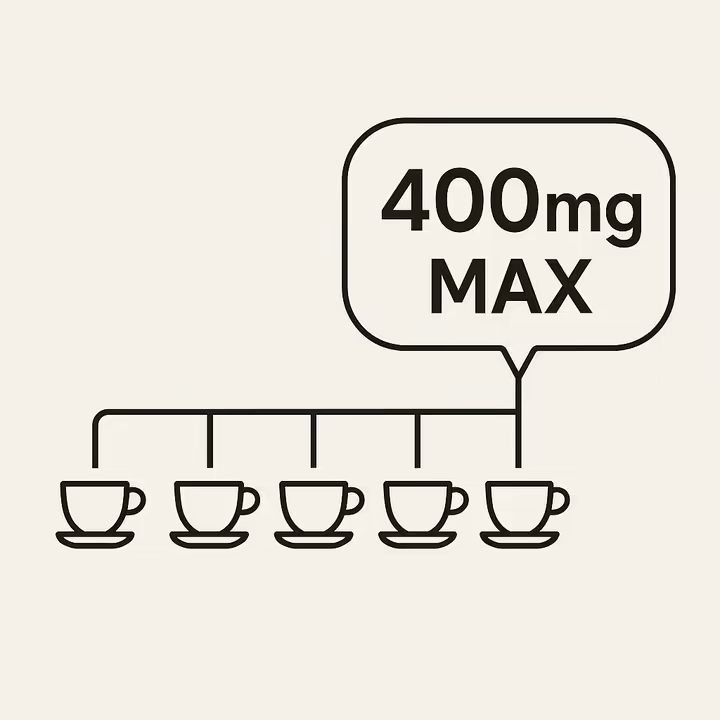
The 400 mg guideline equals about five to six single espresso shots, while the 200 mg limit is about two to three shots. Remember to include caffeine from other sources like tea, soft drinks, and chocolate in your total daily count. 51
Caffeine from espresso is absorbed quickly, with stimulant effects felt in as little as 10 minutes and peak blood levels reached in 30 to 120 minutes. 53, 55 Its half-life, the time for the body to eliminate 50% of it, ranges from 1.5 to 9.5 hours, averaging 3 to 7 hours for most adults. 54 This variation is due to genetic differences in the CYP1A2 liver enzyme, which metabolizes caffeine. 57
This genetic difference explains why "fast metabolizers" are less affected by caffeine later in the day, while "slow metabolizers" may experience jitteriness or sleep disruption. 50 Due to its long half-life, consuming caffeine within six hours of bedtime can interfere with sleep. 53
Key Takeaways
The caffeine in an espresso shot varies from 30 mg to over 100 mg, with an average of 63 mg. The most important factor is the bean type, as Robusta has nearly twice the caffeine of Arabica. A shot's intense flavor does not indicate higher caffeine, a milder lungo shot actually contains more total caffeine than a concentrated ristretto.
When comparing typical servings, a 12-ounce drip coffee often has more total caffeine than a 2-ounce double espresso. Healthy adults can safely consume up to 400 mg of caffeine daily, equal to about five or six single shots. Always consider your individual sensitivity and total caffeine intake from all sources.
Works cited
- Espresso vs. Coffee: What's The Difference + Is One Healthier? - MindBodyGreen, https://www.mindbodygreen.com/articles/espresso-vs-coffee
- Sources & Amounts - Everything Caffeine, https://caffeine.foodinsight.org/sources-amounts/
- How Much Caffeine Is in a Shot of Espresso? - OutIn, https://outin.com/blogs/news/espresso-caffeine-content
- How much Caffeine in you average espresso shot? : r/Coffee - Reddit, https://www.reddit.com/r/Coffee/comments/8mt4o5/how_much_caffeine_in_you_average_espresso_shot/
- The Ultimate Guide to Understanding the Caffeine Content in Coffee and Espresso, https://cliffandpebble.com/blogs/our-blog/how-much-caffeine-in-a-shot-of-espresso-unveiling-the-facts
- Coffee versus Espresso: Unraveling the Caffeine Mystery, https://www.compasscoffee.com/blogs/the-daily-grind/coffee-vs-espresso-unraveling-the-caffeine-mystery
- The Truth About Caffeine Content in Espresso: Is it THAT strong?, https://coffeechronicler.com/caffeine-content-in-espresso/
- stonestreetcoffee.com, https://stonestreetcoffee.com/blogs/brooklyn-coffee-academy/robusta-is-the-most-caffeinated-coffee-bean-type-and-if-you-re-not-drinking-it-you-re-missing-out#:~:text=Arabica%2C%20the%20most%20popular%20coffee,and%20more%20naturally%20bitter%20flavor.
- Why you should Drink Robusta Coffee Beans, https://stonestreetcoffee.com/blogs/brooklyn-coffee-academy/robusta-is-the-most-caffeinated-coffee-bean-type-and-if-you-re-not-drinking-it-you-re-missing-out
- The difference between the coffee types of Arabica and Robusta - Lavazza, https://www.lavazzausa.com/en/recipes-and-coffee-hacks/difference-type-arabica-robusta-coffee
- Caffeine level : r/Coffee - Reddit, https://www.reddit.com/r/Coffee/comments/1fxjpyh/caffeine_level/
- Light vs Dark: Caffeine Content in Coffee Roasts, https://bellwoodcoffee.com/blogs/roaster-notes/light-v-dark-caffeine-content-in-coffee-roasts
- A Bit About Caffeine - CoffeeGeek, https://coffeegeek.com/blog/techniques/a-bit-about-caffeine/
- Does Light Roasted and Dark Roasted Coffee Differ in Caffeine Content?, https://www.terbodore.com/blogs/general-news/does-light-roasted-and-dark-roasted-coffee-differ-in-caffeine-content
- Does lightly roasted coffee contain more caffeine than dark roasted? - Reddit, https://www.reddit.com/r/Coffee/comments/vfvea7/does_lightly_roasted_coffee_contain_more_caffeine/
- Dark Roast vs Light Roast Coffee: Let's Talk Caffeine Content - Five Lakes Coffee, https://fivelakes.com/blogs/coffee-methods/dark-roast-vs-light-roast-lets-talk-caffeine-content
- Caffeine in an Espresso Shot: Brewing, History, and Science ..., https://generalwarfieldscoffee.com/blogs/our-blog/caffeine-in-an-espresso-shot
- Caffeine Myths: Espresso vs Drip Coffee – Kicking Horse Coffee - USA, https://www.kickinghorsecoffee.com/pages/caffeine-myths-espresso-vs-drip-coffee
- Caffeine Myths: Espresso vs Drip - Kicking Horse Coffee, https://kickinghorsecoffee.com/pages/caffeine-myths-espresso-vs-drip-coffee
- Ristretto vs Long Shot (Lungo): Are They Really That Different? - Home Coffee Expert, https://homecoffeeexpert.com/ristretto-vs-long-shot/
- Ristretto vs. Long Shot (Lungo): Ultimate Espresso Guide - 1Zpresso, https://1zpresso.coffee/ristretto-vs-long-shot/
- Which of these espresso variant contain more caffeine? - Coffee Stack Exchange, https://coffee.stackexchange.com/questions/2076/which-of-these-espresso-variant-contain-more-caffeine
- 24 Popular Starbucks Drinks Ranked By Their Caffeine Content | Lifeboost Coffee, https://lifeboostcoffee.com/blogs/lifeboost/starbucks-caffeine-guide-24-popular-drinks-ranked-by-their-caffeine-content
- Starbucks Caffeine: 24 Drinks Ranked by Caffeine Content - Corner Coffee Store, https://cornercoffeestore.com/starbucks-caffeine-guide/
- PSA: Espresso shots honestly aren't that much caffeine : r/starbucks, https://www.reddit.com/r/starbucks/comments/kg1ssk/psa_espresso_shots_honestly_arent_that_much/
- Dunkin espresso hits harder than starbucks. : r/DunkinDonuts - Reddit, https://www.reddit.com/r/DunkinDonuts/comments/125ycxx/dunkin_espresso_hits_harder_than_starbucks/
- Dunkin' Donuts Coffee Guide: History , Caffeine Content & Best Drinks, https://cornercoffeestore.com/dunkin-donuts-coffee-caffeine-content/
- Dunkin Donuts: Caffeine Per Dollar - Efficiency Is Everything, https://efficiencyiseverything.com/dunkin-donuts-caffeine-per-dollar/
- How much caffeine is in my beverage? - Peet's Coffee, https://faq.peets.com/hc/en-us/articles/204763419-How-much-caffeine-is-in-my-beverage
- www.contact.nespresso.com, https://www.contact.nespresso.com/faq-3/ro/en
- What is the caffeine content of a Original Nespresso capsule?, https://www.contact.nespresso.com/faq/ro/en/detail/2188
- Nespresso Customer Service & FAQs, https://www.nespresso.com/us/en/service-faq
- Nespresso Caffeine Content: A Brief Guide To Nespresso Pod - Lifeboost Coffee, https://lifeboostcoffee.com/blogs/lifeboost/nespresso-caffeine-content-a-brief-guide-to-nespresso-pod
- What is the caffeine content of Nespresso capsules?, https://www.contact.nespresso.com/faq/ca/en/detail/5239
- the ultimate 2024 nespresso caffeine guide: every virtuo pod ranked by mg from least to most (espresso, double, lungo, and more) - Reddit, https://www.reddit.com/r/nespresso/comments/1fy6pse/the_ultimate_2024_nespresso_caffeine_guide_every/
- Caffeine | EFSA - European Union, https://www.efsa.europa.eu/en/topics/topic/caffeine
- EFSA opinion on the safety of caffeine | Eufic, https://www.eufic.org/en/whats-in-food/article/efsa-opinion-on-the-safety-of-caffeine
- The Caffeine Difference: Which Has More Caffeine – An Americano or a Cup of Coffee?, https://www.cbcbev.com/caffeine-difference-between-an-americano-and-average-cup-of-coffee/
- Caffeine Content: Espresso vs. Drip vs. Cold Brew - Fifty5 Rivers, https://fifty5rivers.com/journals/caffeine/caffeine-amounts-by-brewed-coffees/
- Caffeine Levels in Different Brews: Espresso vs. Drip vs. Cold Brew, https://rockcreekcoffee.com/blogs/blog/caffeine-levels-in-different-brews-espresso-vs-drip-vs-cold-brew
- Cappuccino vs Latte Caffeine: The Ultimate Comparison Guide - Majesty Coffee, https://majestycoffee.com/blogs/posts/cappuccino-vs-latte-caffeine
- majestycoffee.com, https://majestycoffee.com/blogs/posts/cappuccino-vs-latte-caffeine#:~:text=In%20conclusion%2C%20the%20caffeine%20content,foam%20used%20in%20their%20preparation.
- Cappuccino vs. Latte vs. Macchiato — What's the Difference? - Healthline, https://www.healthline.com/nutrition/cappuccino-vs-latte-vs-macchiato
- Cappuccino vs Latte | Coffee Culture | Nescafé UK & IE, https://www.nescafe.com/gb/coffee-culture/knowledge/latte-vs-cappuccino
- How Much Caffeine Is in Decaf Coffee? - Healthline, https://www.healthline.com/nutrition/caffeine-in-decaf
- colipsecoffee.com, https://colipsecoffee.com/blogs/coffee/decaf-espresso
- Amount of Caffeine in Decaf Espresso: Surprising Facts - Equipoise Coffee LLC, https://equipoisecoffee.com/amount-of-caffeine-in-decaf-espresso/
- www.fda.gov, https://www.fda.gov/consumers/consumer-updates/spilling-beans-how-much-caffeine-too-much
- EFSA says it's safe to drink up to six espressos per day - Comunicaffe International, https://www.comunicaffe.com/efsa-says-its-safe-to-drink-up-to-six-espressos-per-day/
- Caffeine: How much is too much? - Mayo Clinic, https://www.mayoclinic.org/healthy-lifestyle/nutrition-and-healthy-eating/in-depth/caffeine/art-20045678
- Food supplements containing caffeine - Food Standards Scotland, https://www.foodstandards.gov.scot/consumers/food-safety/buying-food-eating-out/food-supplements-containing-caffeine
- Guidelines on caffeine intake - Coffee & Health, https://www.coffeeandhealth.org/health/coffee-and-caffeine/guidelines-on-caffeine-intake
- How Long Does Caffeine Stay in Your System? - Healthline, https://www.healthline.com/health/how-long-does-caffeine-last
- Pharmacology of Caffeine - Caffeine for the Sustainment of Mental Task Performance - NCBI, https://www.ncbi.nlm.nih.gov/books/NBK223808/
- How long does caffeine take to kick in? - BBC Science Focus Magazine, https://www.sciencefocus.com/the-human-body/how-long-does-caffeine-take-to-kick-in
- Caffeine - Wikipedia, https://en.wikipedia.org/wiki/Caffeine
- Influence of Various Factors on Caffeine Content in Coffee Brews - PMC - PubMed Central, https://pmc.ncbi.nlm.nih.gov/articles/PMC8228209/